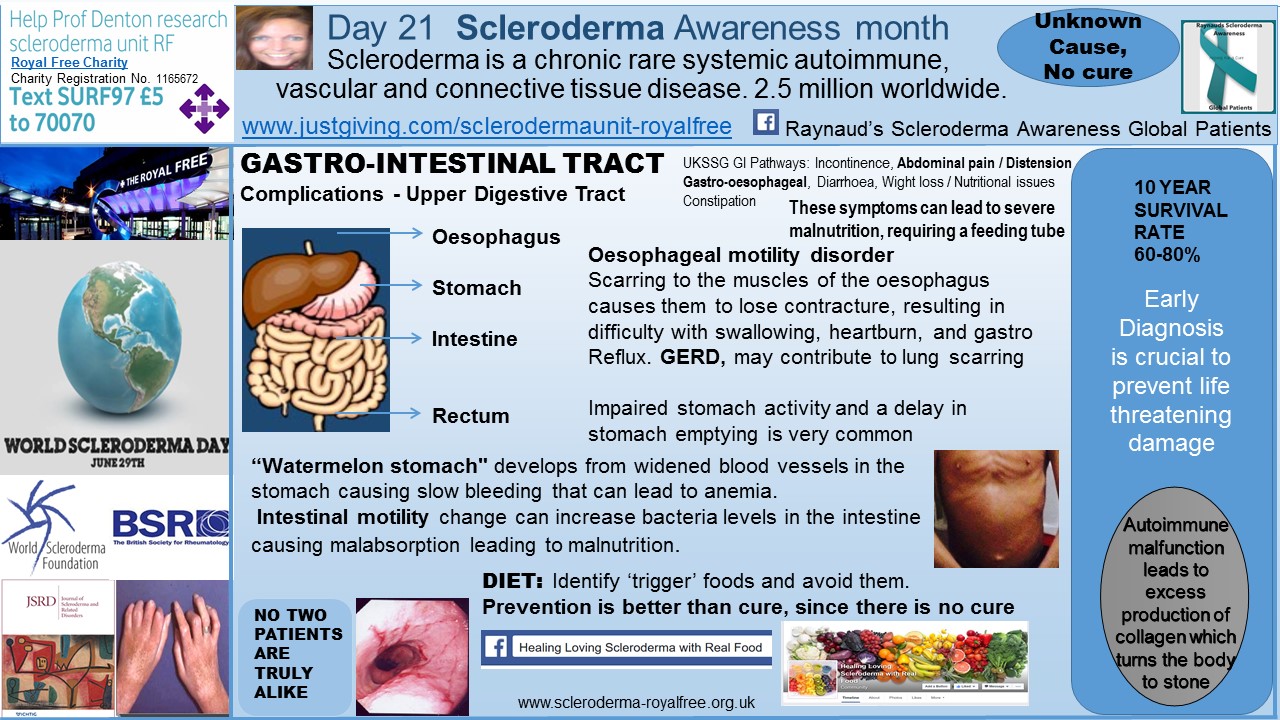DAY 21 Scleroderma Awareness Month: UPPER Gastro-Intestinal Tract
Written by |

DAY 21 Scleroderma Awareness Month: UPPER Gastro-Intestinal Tract
Scleroderma can affect the entire gastro-intestinal system starting from the mouth all the way down to the anus. Please see Day 11 SclerodermaAwareness Month for a general discussion of these symptoms — click here.
Dry mouth, along with difficulty in swallowing and mouth opening, can be a challenge. I focused on the mouth and dental issues in Day 18 Scleroderma Awareness Month, highlighting the difficulty with chewing and gum recession and all that this entails.
Heartburn and acid at the back of the throat is a frequent, most unpleasant symptom, with no adequate treatment or cure available. The proton pump inhibitor (PPI) class of drugs provide some relief, however, more recent studies have shown that long term use brings along further problems.
Scleroderma can affect the gut lining and gut muscle, compromising food absorption and digestion. This is often accompanied by a bloating, “full” feeling after a couple of mouthfuls of food. This can eventually lead to malnutrition due to the body not having access to the relevant nutrition.
A watermelon stomach can be seen in some patients due to a change in the blood vessels, as can be seen in the image above.
In the most severe of cases, a feeding tube is necessary.
Medications can also exacerbate GI symptoms.
Over the years, I have learnt to identify my trigger acid-inducing foods, and make sure that I avoid them in the hope to prevent any acid excess. I have daily fruit and vegetable juices, which have most definitely improved my symptoms and improved my energy. To read more about this, click here.
My fellow scleroderma patient and American friend Kelli started the Facebook page ‘Healing Loving Scleroderma with Real Food,’ which I also contribute to.
Since changing her diet and including daily fresh juices, Kelli has experienced similar results to me, improving her symptoms and their management, which she shares on the Facebook page.
Slow mobility of food and digestion can lead the micro flora of bacteria in the gut to become overgrown, adding to the GI symptom list. Excessive antibiotic use can lead to internal candida and the complications that this then brings.
As I explained in the blog post for Day 11 Scleroderma Awareness Month, I have learnt that prevention is better than cure when it comes to GI symptoms. I avoid my trigger foods, ensure daily juices for optimum nutrition, and hope for the best!
To see the UK Scleroderma Study Group guidelines for best practice in GI management, click here.






